
Businesses are constantly looking for innovative solutions to enhance warehouse design and operational effectiveness, and simulation modeling moves the needle in your favor. With it, operations like yours can examine any system or process virtually by observing, analyzing, and optimizing its performance.
One chief concern is warehouse layout, which impacts the flow of goods, accessibility, and the overall speed and accuracy of order fulfillment. Warehouse layout optimization can minimize operational costs while improving customer satisfaction with efficient deliveries.
Warehouse design and layout decisions used to be based on intuition and experience. but with the advent of advanced analytics and simulation modeling, businesses have access to data-driven insights to inform optimizations. By collecting and analyzing various types of data such as SKU movement and order-picking patterns, you can now make decisions based on your specific operational needs.
That's where discrete event simulation (DES) comes in! Read on to explore the basic principles for warehouse layout optimization and how you can create an effective model.
Understanding DES for Warehouse Layout Optimization
Discrete event simulation (DES) models warehouse process efficiency as a series of distinct events occurring over time. Each event represents a specific change or step in the process, such as the arrival of an item, the start of an operation, or the completion of a task. In DES, variables such as resource scheduling and availability, processing time, and queue lengths can change at discrete points in time, changing the system. Because DES allows you to test potential layouts in a risk-free virtual environment, you can use it to assess warehouse changes without costly and time-consuming physical trials.
Each model offers dynamic views of real-world processes, providing a time-based view of system performance that evolves as events occur. The simulation reflects changes over time using a simulation clock, ensuring that events are processed in the correct sequence and that the simulation moves forward to generate reliable results.
Benefits of Using DES in Warehouse Design
Operations use DES to conduct what-if analyses, compare scenarios, and analyze the KPI implications of their decisions with virtual replicas. Operating as a virtual sandbox, it helps validate solutions before implementation by showing real-world performance, helping you enhance efficiency with various warehouse layout optimizations:
- Optimizing storage locations
- Improving picking performance
- Improving workforce planning with worker allocation
- Planning complex systems involving humans and robots
Data Collection and Preparation
Depending on your goals, several pieces of data are necessary to create accurate simulations. Do you want to shorten shipping times or save on operational costs? Improve picking and packing accuracy or optimize space? No matter the goal or combination of goals, gather key information before you get started with DES:
Operational Processes
Gain a deep understanding of the operational processes within the warehouse. You must understand the sequence of activities, rules, and constraints associated with each process:
- Define how goods are received, sorted, stored, and retrieved.
- Understand the order fulfillment process.
- Factor in packaging requirements.
- Follow shipping procedures.
Knowing every angle of your operational processes ensures that you can accurately model them in the simulation.
Resource Allocation
Think about the equipment and human resources being used. Quantify the resources involved in warehouse utilization, including forklifts, conveyor systems, and automated storage and retrieval systems (AS/RS). Properly modeling the resources helps with scheduling by simulating their interactions and utilization accurately.
Take time to define both what and how resources are used and their limitations. For equipment, this means understanding capacity, availability, and maintenance schedules. But people have their limits, too. Take stock of what impacts human resources, from the number of workers and their skill levels to shift schedules and breaks. Your WMS and maintenance systems are treasure troves for data to improve simulations, make data-driven decisions, and determine how/if to scale up or down.
Performance Metrics
Define the performance metrics that you want to measure and analyze during the simulation. These metrics should align with your goals and objectives. Examples of metrics include:
- Throughput (orders processed per unit of time)
- Order cycle time (time from order placement to shipment)
- Order accuracy
- Labor utilization
- Storage capacity utilization
- Transportation costs
- Customer service levels
Identifying and tracking these metrics and data allows you to evaluate the efficiency of your warehouse operations and find new ways to improve.
Inventory and SKU Data
By taking stock of inventory data, you can create accurate DES models that visualize the movement of goods and spotlight bottlenecks and inefficiencies. This way, you can perform inventory optimization, simulating scenarios to determine effective configurations for:
- Floor plans
- Storage areas
- Racks
- Shelving
- Workstations
- Loading docks
You need SKU data to model the flow of goods under different conditions, including how demand changes, inventory levels, and process improvements impact your system. This information informs how storage allocation impacts picking times, travel distances, and overall throughput so your warehouse can find ways to maximize space, minimize handling times, and improve service.

Model Development
SimWell stands ready to work with your team using an agile methodology to plan, structure, and build models that solve your warehouse optimization challenges. Our 11-step process leaves no stone unturned.
1. Plan Your Model
We kick the process off with a strategic planning session to align stakeholders on the project’s scope and direction, helping you refine your objectives and KPIs while revealing risks and bottlenecks.
2. Draft Your Design Spec
Your design spec is a guide for the simulation model. SimWell relies on a proven template as our guidepost to draft a design spec capable of solving your challenges.
3. Craft Your Prototype
The prototype begins to put your model to the test, helping to understand its accuracy to your operation. During this phase, we can ask key questions about accuracy and performance while identifying details not incorporated in the initial planning.
4. Collect Data
We also need to understand your exact data requirements. With this intel, we can determine data sources to consult and ensure efficient model-building.
5. Construct the Model
Engineers take your complex ideas and distill them into a usable model that visualizes your processes and addresses your specific challenges.
6. Verify and Validate
Make sure your model fulfills its purpose. We align your model with your operations to ensure it can reliably and accurately execute scenario planning.
7. Debug for Integrity
No model is perfect right away. Debugging helps us identify and resolve problems to ensure accuracy and performance.
8. Run and Compare
Is your model ready? SimWell runs a variety of scenarios, analyzing along the way to ensure the model reflects your objectives and KPIs.
9. Execute Decision-Making
Working together with stakeholders, we review the tested scenarios and outcomes to ensure decision-making that aligns with your needs.
10. Empower Through Training
Your model should be easy to use, and we provide training for all users to ensure that everyone from executives to engineers can benefit from it.
11. Ensure Model Longevity
Keep reaping the benefits long into the future with robust documentation to keep the model’s utility intact.
Real-World Examples
Warehouses just like yours have benefited from DES-based layout optimization. Consider how SimWell has applied discrete event simulation to improve both sorting and throughput.
Warehouse Simulation for Automated Sorting
An online CPG retailer needed an automated sorting system to enhance fulfillment, turning to SimWell to create a simulation model that would help with design. The simulation needed to model the conveyor network and workstations, including the amount of time and workers needed for each wave.
Challenge
The customer needed an optimized model that would reflect all the moving parts of their sorting system to drive maximum efficiency. The simulation had to be capable of testing different scenarios in support of several goals:
- Reduce conveyor network traffic
- Reduce conveyor network travel distance
- Reduce lead time for order processing
- Increase throughput
Solution
The SimWell team created a configurable conveyor network by updating the number of loops and workstations. Two process flows were simulated:
- Delivery to the station: Orders are fulfilled by sending crates carrying a single SKU to workstations based on demand specified in an input Excel sheet. Crates supply the required quantities or keep orders open until the demand is met. Empty crates exit the network or are picked up at the stations.
- Pickup from the station: Empty crates are fed into the network to collect SKUs from stocked workstations before moving to designated workstations to minimize waiting and lead time, picking up multiple SKUs before exiting the network.
Results
These simulations worked to optimize crate feeding sequences in the conveyor system, reduce workstation queuing, and increase facility throughput. To simulate different scenarios and configurations, users can alter controllable parameters, including but not limited to:
- Conveyor type
- Feed rate
- Conveyor speed
- Queue waiting time
- Processing time
Warehouse Design for Better Throughput
To accommodate impressive retail traffic, one client needed to create an equally impressive warehouse design. They turned to SimWell for greenfield analysis and simulation support to answer questions surrounding both resources and design needs. The simulation model needed to provide a budget-friendly way to understand resources and make accurate business decisions.
Challenge
With a complex infrastructure of numerous dock doors, staging areas, pallet/SKU categorization, sortation stations, and conveyor systems, the client needed a risk-free way to test their system. On top of this, each activity involved several variables. As a result, simulation became the only compatible solution to understand and prevent bottlenecks.
Solution
SimWell began by collecting data on current warehouse operations, including layout, order fulfillment processes, and staffing levels, to create a simulation model. Built in Anylogic, the model represented warehouse operations, testing against forecasted inbound volume increases. This allowed the client to test different scenarios, including:
- Layout changes
- Conveyor speeds
- Order fulfillment processes
- Staffing levels
Results
Simulation revealed concerns over how well the main conveyor and processing stations could handle increased volumes, with bottlenecks around inbound pallet turnaround and truck queues.
Thanks to simulation modeling, the client was able to spot bottlenecks before implementation, cutting costs. They walked away with recommendations for redesigning the inbound conveyor system and can continue to test how various conveyor configurations meet their operational needs.
Outfit Your Warehouse for Your Needs with Discrete Event Simulation
Using DES for warehouse layout optimization can put your organization on the path to success. Simulations of your operations provide new insights into the effects of process changes upstream and downstream. With this visibility, it’s much easier to right-size your warehouse—from dock doors and layout to equipment and processes.
You can rest easy knowing that your design works for your needs. The risk of the system not meeting objectives is significantly lowered in a tailored design, where you can test and validate operations like wave planning. This trust will permeate the organization to boost stakeholder alignment and confidence, too. DES offers the flexibility to scale within your operation and across your network, making it invaluable for warehouse layout optimization.






